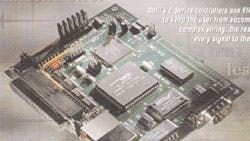As industrial Ethernet continues to make its way to lower levels of the plant hierarchy, standards organizations and automation suppliers alike are endorsing its suitability for device-level applications. The issues of determinism and transmission of in-line power that once plagued Ethernet have been almost entirely eradicated, making it a powerful open networking choice for not only office communication, but also for plant-level applications that once used only proprietary physical protocols.
“Ethernet’s switching capabilities (to address packet collisions), continued increase in speed (to address throughput), and packet prioritization capabilities (to address timesensitive data) make it more deterministic and acceptable for many time-critical applications,” says Leo Vanderschuur, network design engineer and six sigma black belt at GE Cisco Industrial Networks, Charlottesville, Va. “It is also now possible to transmit both signal and power to field devices on the same wires. Power is delivered over previously unused wires in standard Category 5 cable. Several vendors have already implemented this technology into Ethernet switches.”
However, adding Ethernet to the sensor level of an industrial network still requires justifying cost, regardless of its ability to reduce wiring and programming requirements throughout the entire system. “This is particularly true as long as the cost of an Ethernet interface, plus power to the device if necessary, exceeds the cost of a similar configuration using a standard device network,” says Chantal Polsonetti of the ARC Advisory Group, Dedham, Mass. “In spite of efforts designed to push Ethernet to the lowest levels of the automation hierarchy, the reality is that most manufacturers will end up with a continued cascade of automation networks from the supervisory through control and ultimately device levels. Traditional device networks such as PROFIbus DP and DeviceNet have established a firm foothold in the marketplace, and in the near term many manufacturers will continue to specify these networks for their low-cost, real-time, multi-drop capabilities.”
Despite the cost considerations of bringing Ethernet to the factory floor, many organizations and experts are predicting that it will continue to gain popularity at the sensor level. In fact, according to a study conducted by the U.S. division of Intex Management Services (IMS), Austin, Tex., the use of Ethernet at the device level of automation in North America shows potential for significant growth and is expected to more than double over the next three years. “The low cost of the Ethernet chip and the high transmission rate (100 BT), make Ethernet a better candidate for sensor interface,” concurs Jacob Tal, president of Galil Motion Control, Inc., Rocklin, Calif. “Ethernet is already robust on the plant floor. If noise is the issue, one can always use fiber optics.”
Paul Wacker, technical marketing manager at Lantronix, Irvine, Calif., agrees. He says that although the cost of adding Ethernet at the sensor level can only be justified by the functionality of the sensor itself (or by concentrating multiple sensors into one Ethernet interface), cost can be dramatically decreased by using a highly integrated, Ethernet- ready solution. “It’s easy to offer a RFID sensor, barcode scanner, a motion controller, or any $500+ device with an integrated Ethernet port,” he says. “It’s pretty tough to offer an 8-mm proximity sensor with Ethernet for $15.”
A new category of Device Networking ICs that are now available from Lantronix offer this integrated solution. The ICs include a microprocessor, memory, support peripherals, and an Ethernet controller on a single chip. “These single-chip solutions are capable of not only performing communication-related tasks, but also take on the primary tasks of the specific device,” Wacker says. “Manufacturers that utilize these chips also realize a significant space savings, since the conventional approach to an Ethernet design can take as much as six square inches of board space compared to one square inch or less for a single chip solution.” The Lantronix DSTni-LX chip includes an enhanced 80186 processor, on-chip memory, integrated peripherals, and communications controllers to support the most popular networks — including Ethernet. Lantronix also offers all required software, including a real-time operating system and TCP/IP protocol stack.
“In addition to serving as a foundation for Ethernet-enabled devices, these single-chip solutions can used to solve a number of other problems,” Wacker adds. “Network gateways bridge different networks, like DeviceNet to Ethernet. Multiprotocol communications adapters offer manufacturers a way to stretch a single hardware design across applications. A digital servo manufacturer could offer a network adapter that offers PROFIbus, DeviceNet, Ethernet/ IP, Modbus/TCP and other protocols with a single design.”
Galil offers another way to streamline connectivity with its modular 3425 Ethernet products that let system designers run only one wire — the Ethernet cable — from the host out to the device, which dramatically reduces total wiring requirements. “This also keeps all noiseprone signal cables short,” Tal says. “The local I/O is handled by the slave module and continuously updates its status to the host. The programming of the overall system is simplified, because the master controller passes motion data and I/O handling to the slaves automatically.” Each of the Galil 3425 controllers can connect to eight devices over Ethernet. Handles can connect to any Ethernet device that communicates with ASCII text. Common devices include cameras, Ethernet I/O modules, HMIs, and monitoring stations. “Simple, reliable packetized Ethernet data does and will continue to provide safe and affordable motion and I/O automation solutions,” Tal adds.
Due to the fact that it is an open standard with great bandwidth and flexibility, Ethernet has forced fieldbus competitors to develop Ethernet application layers for the industrial arena. The system designer can choose the protocols that best fit at the application layer, which increases performance and promotes customization. “Ethernet also offers great scaleability, something that most industrial networks don’t,” Wacker says. “In addition, Ethernet and TCP/IP pave the way for connecting the factory floor to the front office.” Vanderschuur agrees by adding, “Ethernet- TCP/IP continues to grow as the physical, network, and transportlayer protocols of choice by fieldbus organizations. While application layers will remain different, industrial Ethernet will benefit from common infrastructures and transport mechanisms.”
